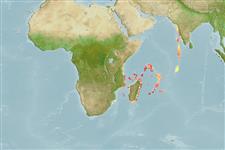Bivalvia |
Ostreida |
Ostreidae
Environment: milieu / climate zone / गहराई सीमा / distribution range
पारिस्थितिकी
. Tropical
Indo-Pacific.
Length at first maturity / आकार / Weight / Age
परिपक्व अवधि: Lm ? range ? - ? cm Max length : 3.0 cm TL पुल्लिंग / अलिंग; (संदर्भ 2922)
Mid-littoral to a few meters. Found attached to the undersides of limestone rocks and dead coral blocks on silty sand. Depth estimate based on ecology (Ref. 63396).
Life cycle and mating behavior
परिपक्व अवधि | पुनरुत्पत्ति | मछलीऔ का अंडे देना | Eggs | Fecundity | Larvae
Members of the class Bivalvia are mostly gonochoric, some are protandric hermaphrodites. Life cycle: Embryos develop into free-swimming trocophore larvae, succeeded by the bivalve veliger, resembling a miniature clam.
Oliver, P.G., A.M. Holmes, I.J. Killeen, J.M. Light and H. Wood 2004 Annotated checklist of the marine Bivalvia of Rodrigues. Journal of Natural History 38:3229-3272. (संदर्भ 2922)
IUCN Red List Status
(संदर्भ 130435: Version 2025-1)
CITES status (संदर्भ 108899)
Not Evaluated
CMS (संदर्भ 116361)
Not Evaluated
Threat to humans
Harmless
Human uses
| FishSource |
साधन
अधिक जानकारी
Trophic EcologyFood items (preys)
संघटक आहार
आहार खपत
परभक्षी
Population dynamicsबाढ़
Max. ages / sizes
Length-weight rel.
Length-length rel.
Length-frequencies
Mass conversion
बहुतायत
Life cycleपुनरुत्पत्तिपरिपक्व अवधिFecundityमछलीऔ का अंडे देनाEggsEgg developmentLarvae PhysiologyOxygen consumption
Human RelatedStamps, coins, misc.
इंटरनेट स्रोत
Estimates based on models
Fishing Vulnerability
Low vulnerability (10 of 100).
